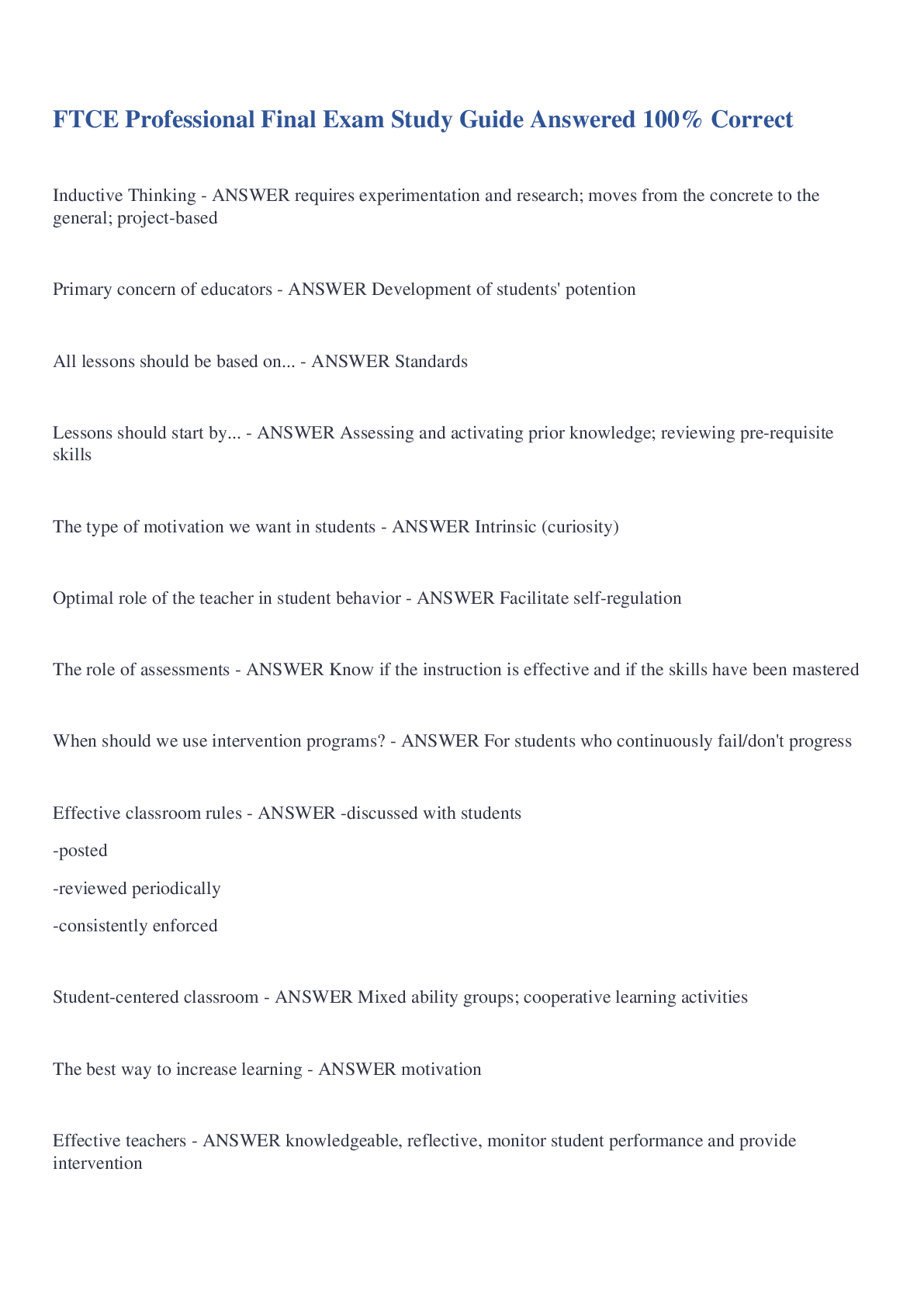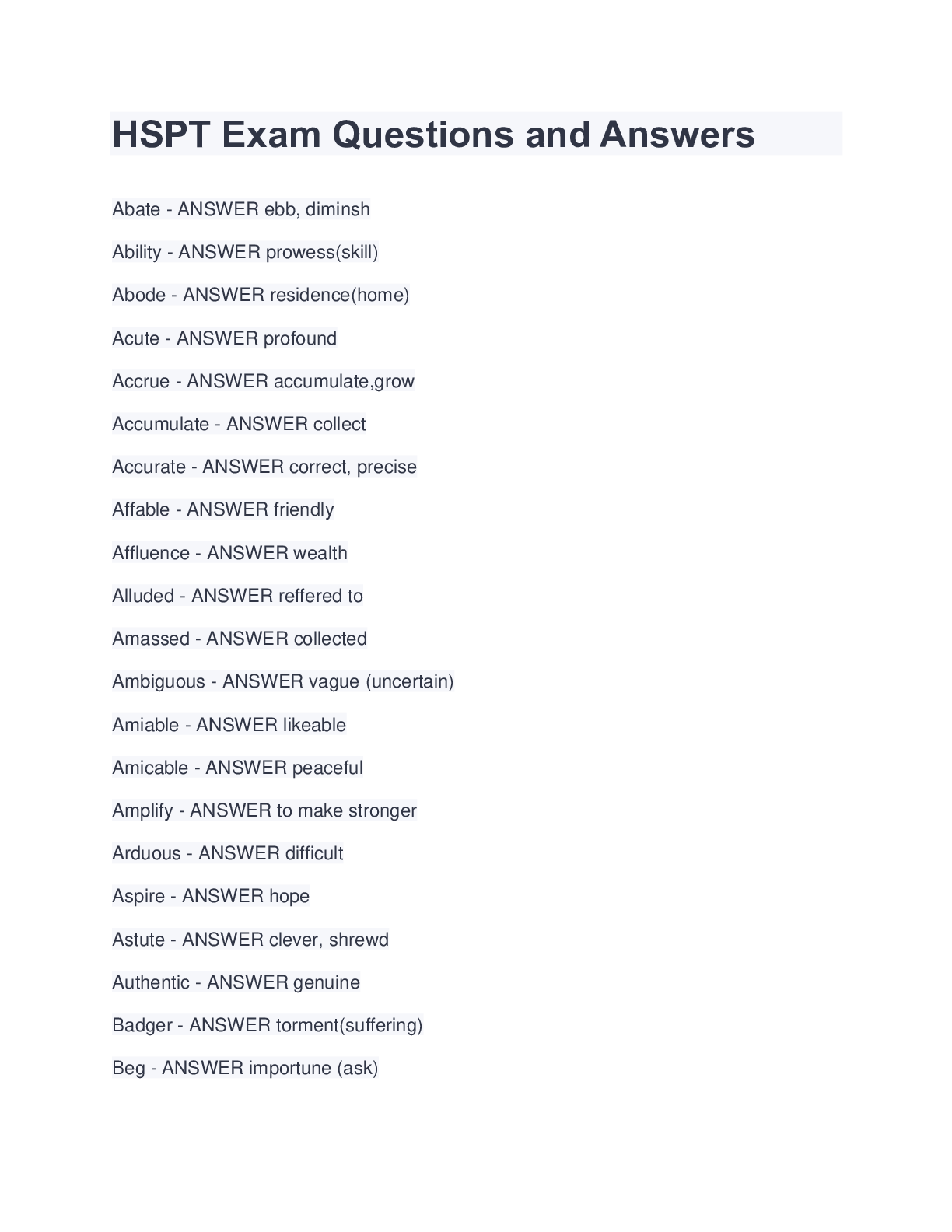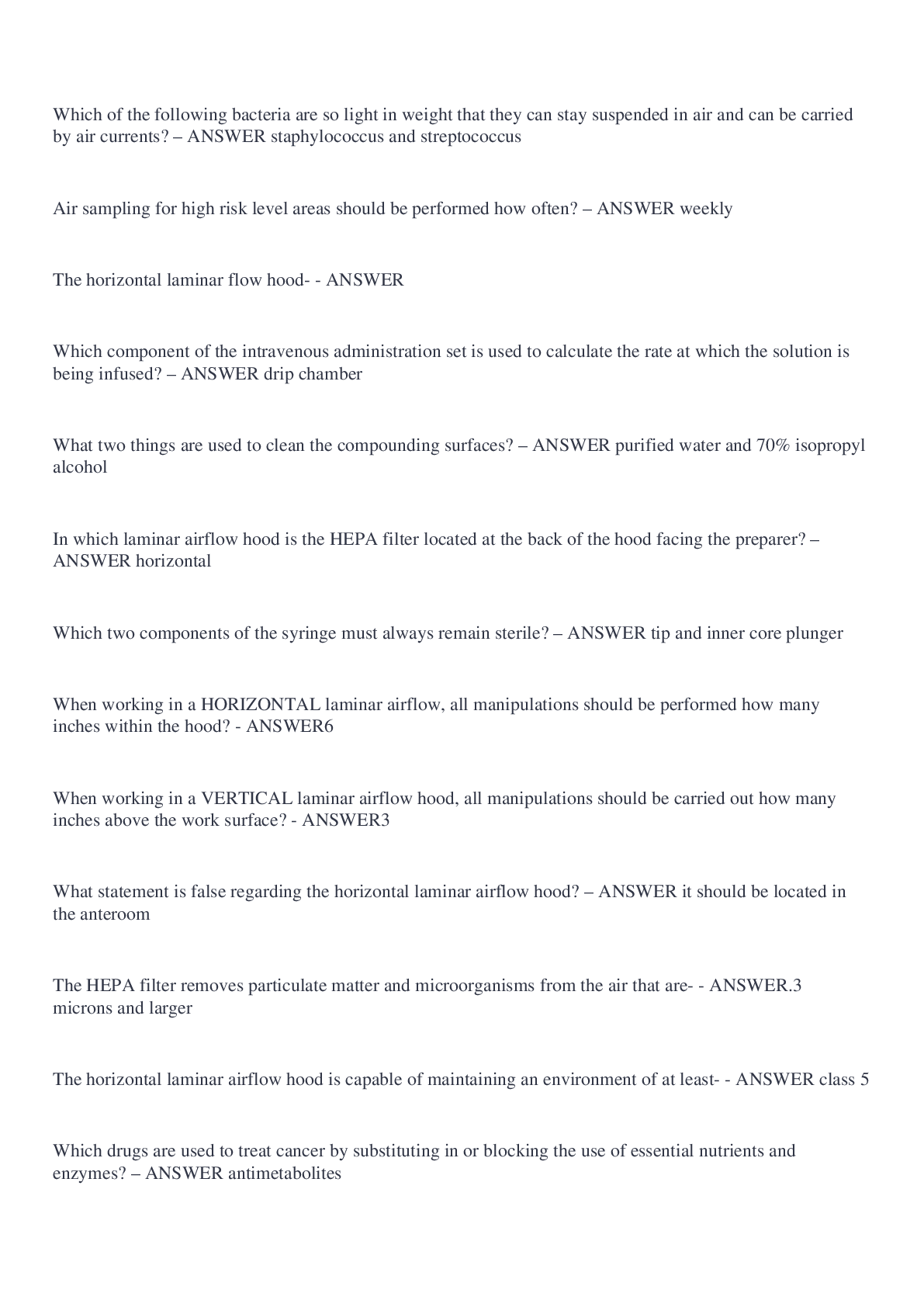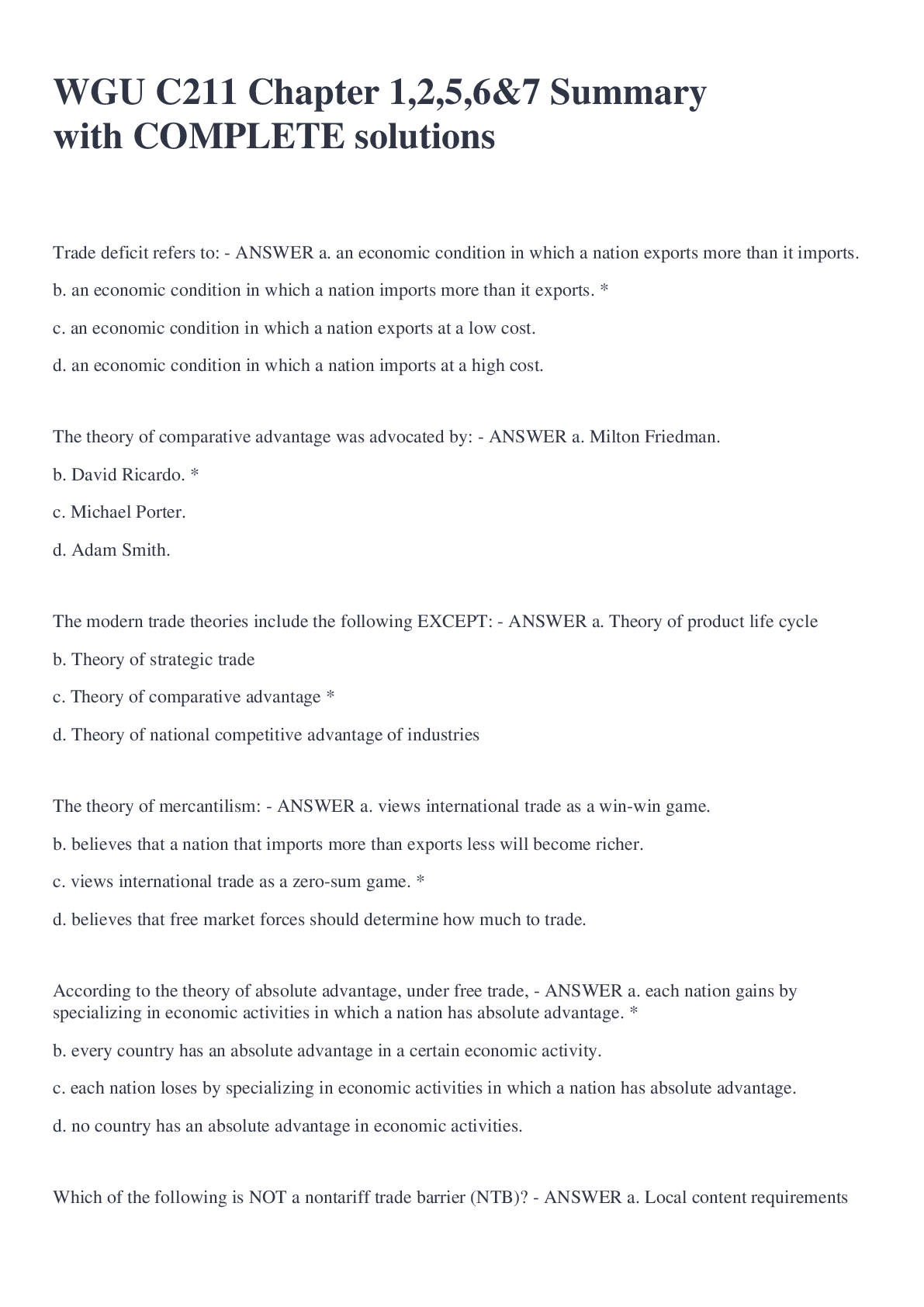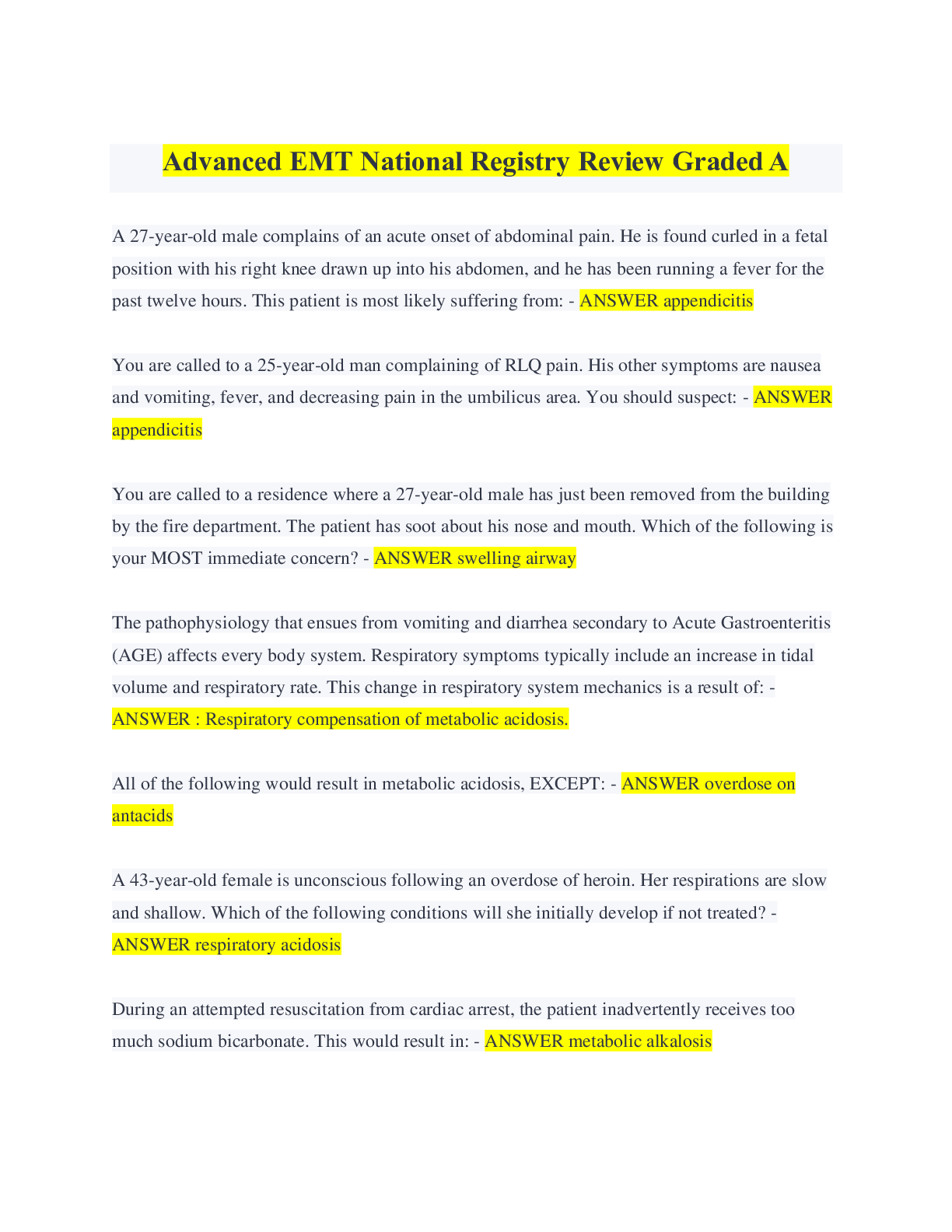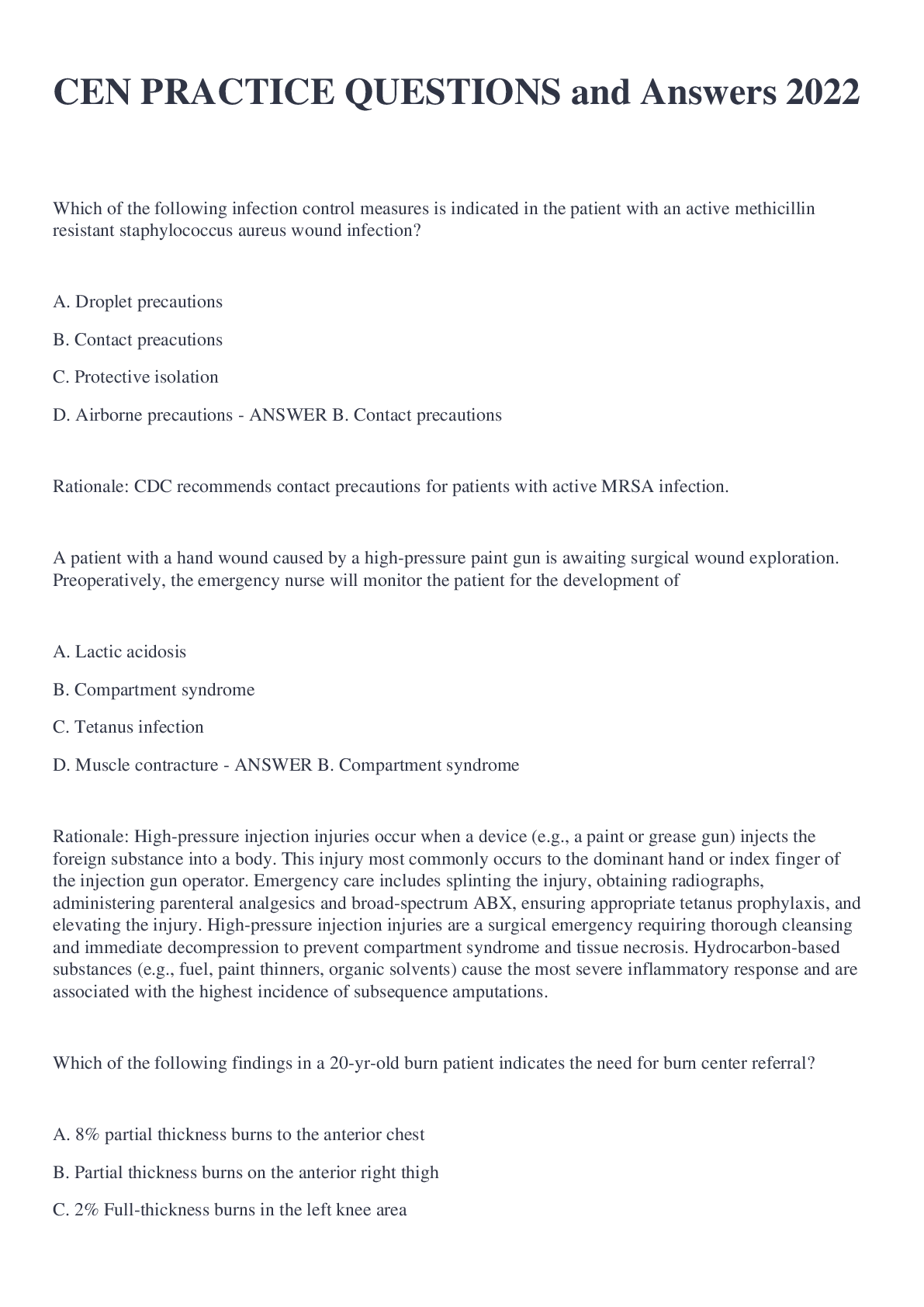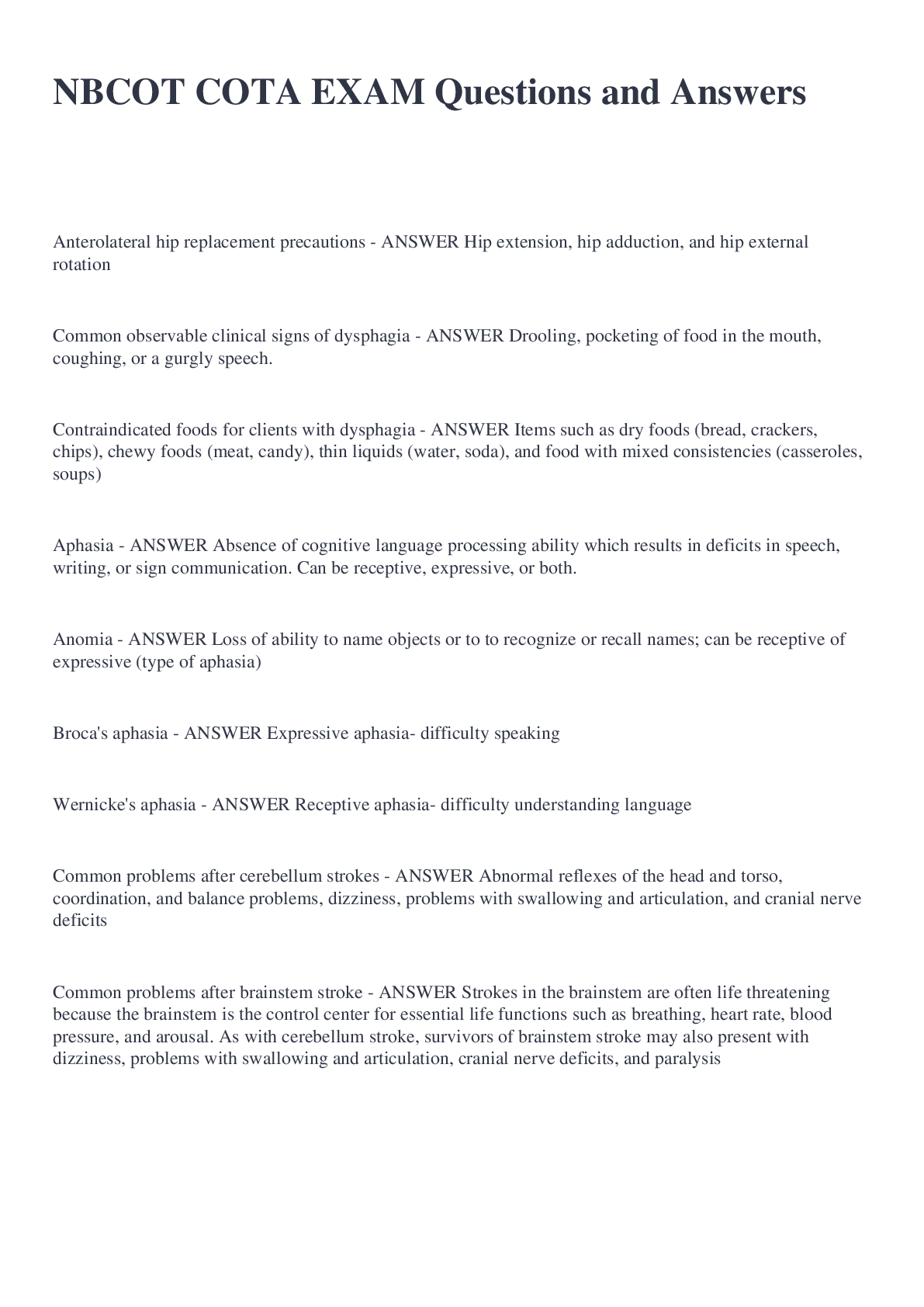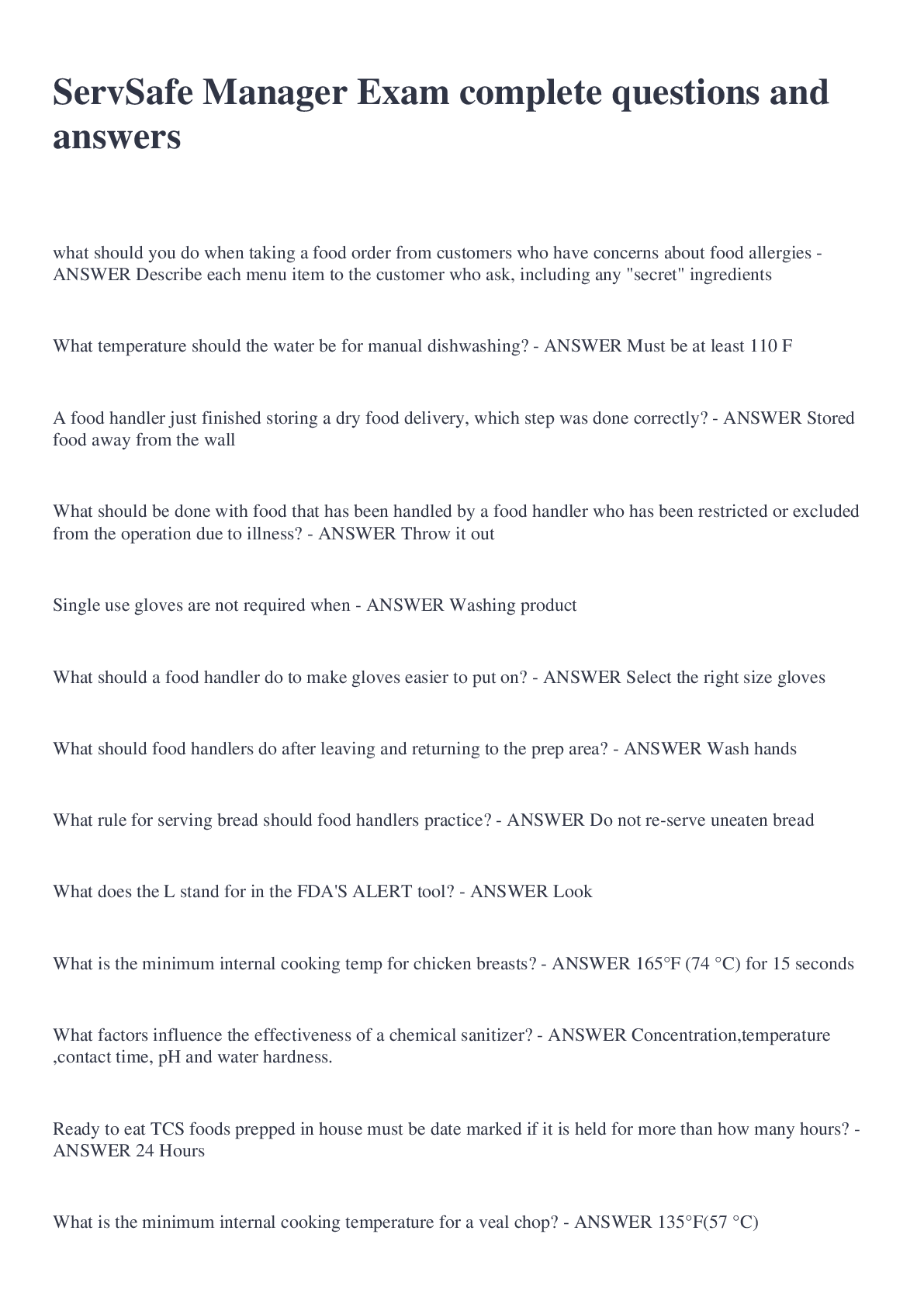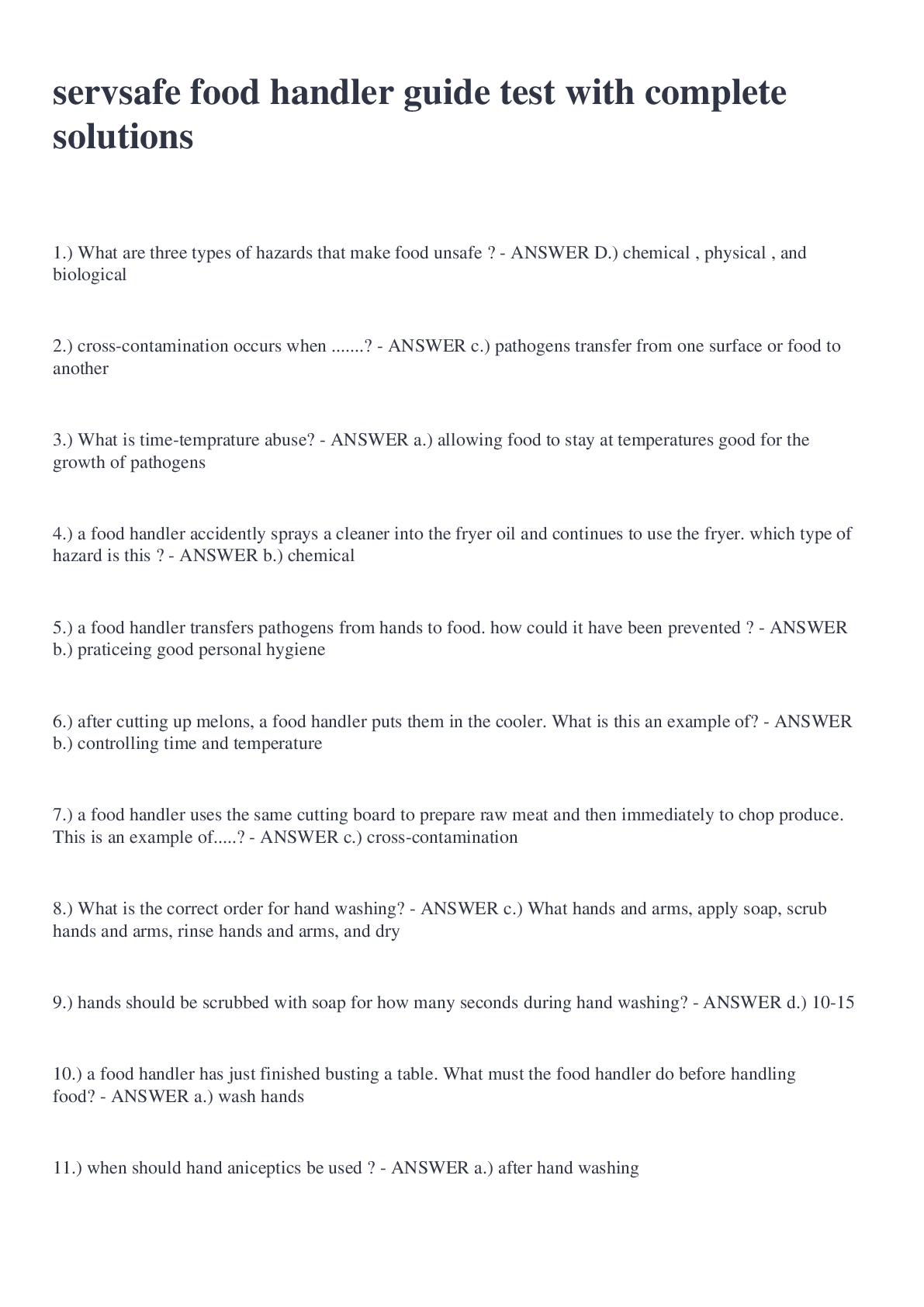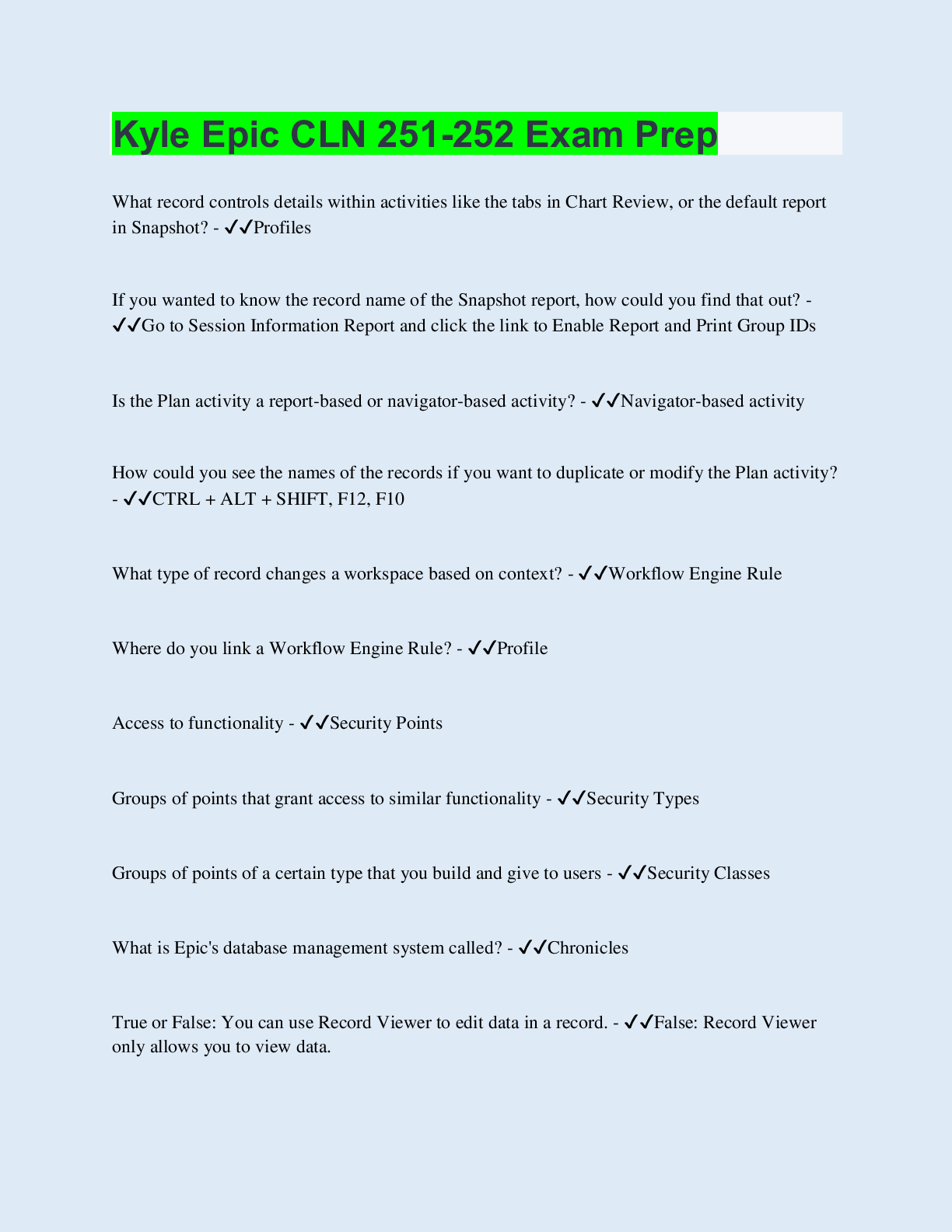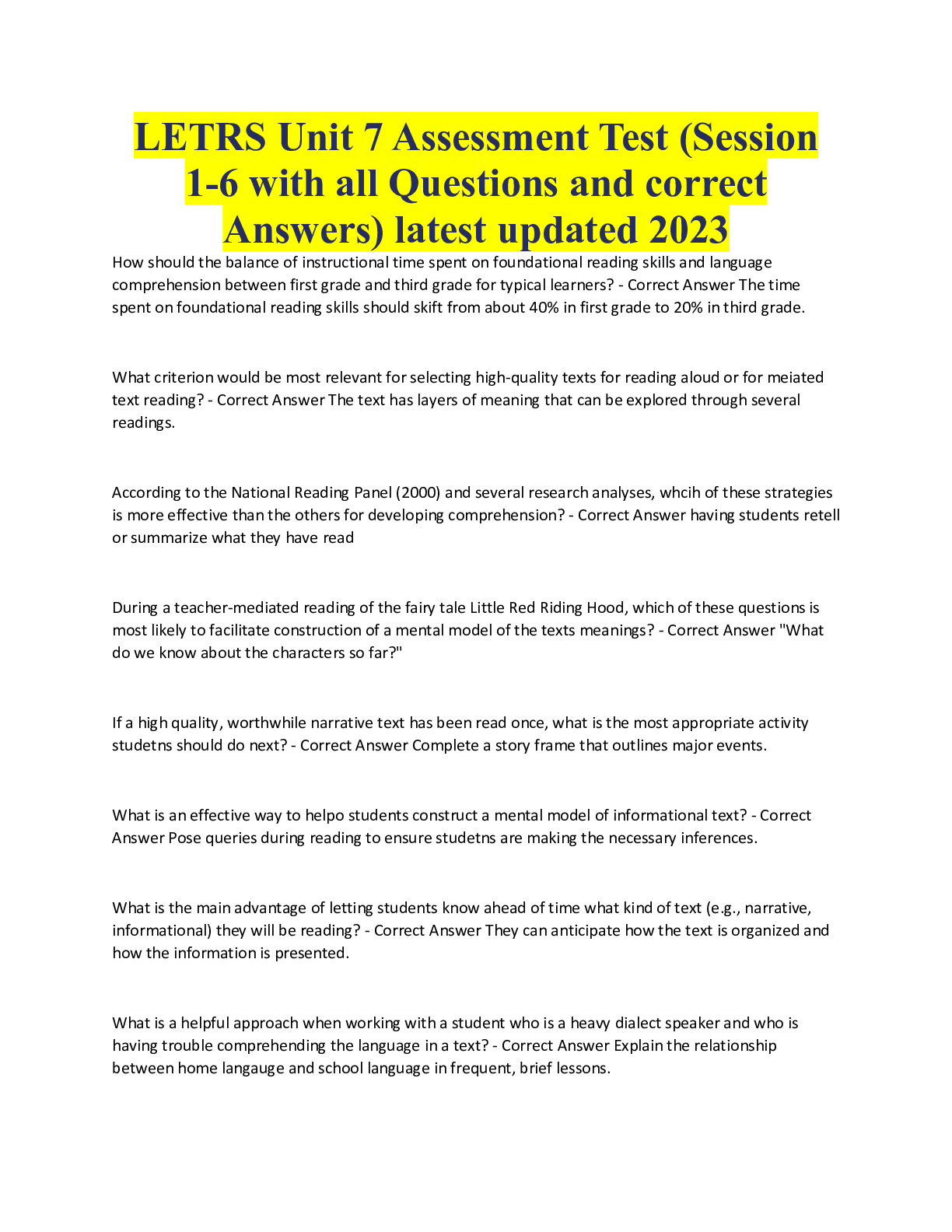Management > EXAM > Health Information Management Final Exam Questions and answers (All)
Health Information Management Final Exam Questions and answers
Document Content and Description Below
Position Descriptions - ANSWER A detailed list of a job's duties, reporting relationships, working conditions, and responsibilities. Planning - ANSWER Is the process of setting goals and objectives... ; of determining desired outcome and defining a course of action. What does planning involve? - ANSWER It involves arranging matters in advance, helps avoid crisis, and anticipates problems. It is generally considered the most important function but often neglected due to no time or unclear objectives from administration. What does lack of planning result in? - ANSWER Crisis Management Problem Analysis - ANSWER A series of methods that can be used to analyze the causes of public problems, where they exist, what effects they have, and what might be done about them. Steps of Problem Analysis - ANSWER Identify the Problem Collect Data Analyzye Data to Understand Problem Decision Making Steps - ANSWER 1. Identify objective 2. Develop alternate solutions 3. Select alternatives that meet requirements 4. Define how and when alternative will be accomplished 5. Develop system for follow up Management - ANSWER The process of planning, controlling, leading, and organizing the activities of a healthcare organization or department within an organization. Strategy - ANSWER A plan, method, or series of maneuvers or stratagems for obtaining a specific goal or result. Action Plan - ANSWER A multistep strategy to identify and achieve your goals. 1. Identify problem or need 2. Obtain and analyze data 3. Determine best action 4. Carry out plan 5. Monitor the process, report progress, and make adjustments Mission - ANSWER Is the overall plan for facility that includes a statement of purpose and philosophy. It is considered a stable force in a changing environment that illustrates environment (demographics, economic, natural technological, political, cultural, resources, values and responsibilities). Strategic Plan - ANSWER The document in which the leadership of a healthcare organization identifies the organization's overall mission, vision, and goals to help define the long-term direction of the organization as a business entity. Usually for a specified period of time such as three to five years. It needs a global approach - not a problem-related approach. Steps for Creating a Strategic Plan - ANSWER Identify key issue areas Develop measurable goals Appoint responsible party such as an individual, group, committee or team to provide oversight and to ensure the goals are met Set target date - due date Tactical Plan - ANSWER One of several types of short-term plans within the planning function. They are usually developed on a yearly basis. Operational Planning - ANSWER The specific day-to-day tasks required in operating a healthcare organization or an HIM department. The road map to guide a healthcare organization or department toward the goals of the strategic plan. Finanical Plans - ANSWER Is a comprehensive evaluation of an investor's current and future financial state by using currently known variables to predict future cash flows, asset values and withdrawal plans. Capital Expenditure - ANSWER These are generally expenditures that will impact department services exceeding one-year period and whose total exceeds a monitory limit pre-established by the governing board. Capital Budget Justifications - ANSWER Statement of purpose Request for proposal (RFP) Benefits analysis Cost analysis Recommendation Priority ranking Time phasing Operating Budget - ANSWER Allocates and controls resources to meet an organization's goals and objectives for a fiscal year. Salaries and Benefits - ANSWER Allocates all of the employee wages and benefits taking into consideration salary and cost of living increases. Programmatic Planning - ANSWER Addresses objectives relating to special projects or programs. An independent consultant may be used to realize a ________________________ plan. Allocated Cost - ANSWER Takes into account departments that are not revenue - producing but are necessary for operation - for example, mainteance, utilities, and insurance. Budget - ANSWER A plan that coverts the organization's goals and objectives into targets for revenue and spending. Many organizations use it with dual purposes. As a planning tool, managers are expected to forecast their department's needs using historical data and anticipated changes. They are often required to provide justification for their budget. As a monitoring tool, managers may be evaluated on how well they stayed within their forecasted budget. Capital Budget - ANSWER A plan that shows the major expenditures and sources of funds for plant and equipment. It drives the forecast upon which all other budgets are developed. One component is the capital expenditure. Revenue and Expense Budgets - ANSWER Are a second type, where the organization includes estimate of gross patient revenue. The primary consideration is based on statistical estimates for occupancy, patient or case mix, ancillary services, and other services, activity level projections. Standard Budget - ANSWER Is organized along functions, services or departments while identifying functional costs, i.e. nursing, lab techs, pathology. Zero-Based Budget - ANSWER Types of budgets in which each budget cycle poses the opportunity to continue or discontinue services based on available resources so that every department or activity must be justified and prioritized annually to effectively allocate resources. Variable Expenses - ANSWER Increase and decrease in proportion to changes in activity level; per unit cost remains constant, ie. postage. Fixed Expenses - ANSWER Are not affected by changes in activity level; per unit cost decreased as activity level rises and increases as activity level falls, ie minor equipment with set monthly fee. Policies - ANSWER The principles describing how a department or an organization will handle a specific situation or execute a specific process. They are clear, simple statements of how an HIM department will conduct its services, actions, or business; and a set of guidelines and steps to help with decision-making. Procedures - ANSWER Define the processes by which the policies are put into action. ________ are written documents that describe the steps involved in performing a specific function. Tell an employee how to do it by providing clear and specific instructions relative to specific area of job performance. A well-written procedure lessens chance of errors. Procedures promote morale through reducing uncertainty and builds confidence through independent functioning. Policy and Procedure Manuals - ANSWER Are invaluable resources. Without manuals as guidelines, management lacks direction and it is vulnerable to inconsistent decision-making. When policies are unwritten, administration may assume personnel responsible for their implementation understand them. In addition, personnel may assume that unwritten policies are without status and can be changed or ignored Activity-Based Budget - ANSWER A budget based on activities or projects rather than on functions or departments. Fixed Budget - ANSWER A type of budget based on expected capacity with no consideration of potential variations. Revenue Budget - ANSWER If department generates revenue (correspondence fees, transcription services). Because it is generally a small amount of revenue - may not need to prepare a ____________ budget. Expense Budget - ANSWER A budget that outlines the anticipated and actual expenses for a responsibility center. Includes anticipated and actual expenses for each responsibility center and for the total organization. Written Policies and Procedures - ANSWER Strengthen the network of communication. For staff to enforce and implement policies and procedures effectively and uniformly, they should reflect what is or should be occurring. Controlling - ANSWER The function in which performance is monitored according to policies and procedures. In HIM, controlling includes monitoring the performance of employees for quality, accuracy, and the timeliness of completion of duties. Leading - ANSWER The function in which people are directed and motivated to achieve the goals of the healthcare organization. In an HIM department, leading involves assigning responsibilities to the tasks the department needs to accomplish. Organization - ANSWER Coordinating all of the tasks and responsibilities of a department to guarantee the work to be accomplished is completed correctly. Principles of Organization - ANSWER Principles that include specialization, functional definition, span of control, hierarchical chain, and unity of command used by managers at all levels. Cultural Competence - ANSWER Skilled in awareness, understanding, and acceptance in beliefs and values of the people of groups other than one's own. Specialization - ANSWER Each employee has a special qualification or skill that allows that individual to perform her or his ability; managers who employ this principle assign work among their reporting employees according to their ____________________. Directing - ANSWER Guiding and motivating employees to accomplish organizational objectives. Motivating and leading employees to achieve organizational objectives. Selection of orientation of new personnel, scheduling, assignments, training, coaching, and resolution of employee grievances. Organizational Structure - ANSWER The framework of authority and supervision for the employees within the healthcare organization. Functional Definition - ANSWER All employee job tasks, responsibilities, and relationships toward each other are clearly defined. Managers who define and adhere to the functions of their department staff provide a healthy working environment. Coordinating - ANSWER Exchanging information and altering activities for mutual benefit and to achieve a common purpose. Cooperation with other sections of the department, other departments, and various staff activities and services. Span of Control - ANSWER The number of employees a person manages is called the _____ ____ _______ and is influenced by the size of the organization. Executive Management - ANSWER The senior management of a healthcare organization, the people who oversee the broad functional area or group of departments or services; this level of management sets the organization's future direction and monitors the organization's operation in those areas. Hierarchial Chain - ANSWER This is a management principle in which each member is assigned a specific rank that reflects her or his level of decision-making authority within the organization. Middle Management - ANSWER The management level in an organization that is concerned primarily with facilitating the work performed by supervisory and staff-level personnel as well as by executive leaders. Unity of Command - ANSWER A human resources principle that assumes that each employee reports to only one specific management position. Supervisory Management - ANSWER Management level that oversees the organization's efforts at the staff level and monitors the effectiveness of everyday operations and individual performance against preestablished standards. Organizational Chart - ANSWER A visual graphic or diagram showing the structure and reporting relationships between positions, departments, and employees of an organization. Vision and Mission Statements - ANSWER A vision statement establishes the scope and purpose of a company and reflects its values and beliefs. A mission statement expresses the specific aspirations of the company. Regularly updated as part of the strategic planning processes. Mission Statement - ANSWER A written statement that identifies the core purpose and philosophies of a healthcare organization; it proclaims the purpose of the organization or department -- why does the entity exist? Vision Statement - ANSWER A short description of an organization's ideal future state. Provides a premise that leaders commit to and dramatize to others. Values Statement - ANSWER A clear and concise description of the fundamental values, beliefs, and priorities of the organization's members. A brief articulation of the principles that guide a company's decisions and behaviors. Goals - ANSWER The broad, long-term accomplishments an organization wishes to attain. Are characterized by specific ends or conclusions. Objectives - ANSWER Specific, short-term statements detailing how to achieve the organization's goals. Milestones to be passed on the journey to reaching a goal. Internal Analysis - ANSWER Involves reviewing the inner working of the healthcare organization to determine strengths and weaknesses of the business practice and process. External Analysis - ANSWER Development of the market assessment to determine opportunities and threats to the future of the organization. Market Assessment - ANSWER Determing the number of positions on the market and the eligible workforce looking for work. Strategic Information Systems Planning - ANSWER The process of identifying and priortizing various upgrades and changes that might be made in an organizations information systems. SWOT Analysis - ANSWER Analysis tool used to outline the organization's strengths and weaknesses, which are internal to the organization, and the opportunities and threats, external to the organization. Workflow - ANSWER Any work process that must be handled by more than on person. Work Analysis - ANSWER A technique that must be handled by more than one person. Change Management - ANSWER The formal process of introducing change, getting it adopted, and diffusing it throughout the organization. Impact Analysis - ANSWER A collective term used to refer to any study that determines the benefit of a proposed project, includng cost-benefit analysis, return on investment, benefits realization study, or qualitative benefit study. Gantt Chart - ANSWER A graphic tool used to plot tasks in project management that shows the duration of project tasks and overlapping tasks. Job Description - ANSWER A detailed list of a job's duties, reporting relationships, working conditions, and reponsibilites. Major Components of a Job Description - ANSWER Title of position Department name Person to whom the position is responsible Position summary - including delegated authorities and responsibilities Major responsibilities of the position Job specifications - human qualifications needed to perform the activities: abilities, skills, education, work experience, traits, judgment, and physical attributes Who usually writes the job descriptions? - ANSWER Usually written by a department director or supervisor and can be used to write recruitment ads for open positions. The description should provide enough information to a prospective employee to determine if he/she can fulfill the responsibilities of the position. PERT Chart - ANSWER A project management tool that diagrams a project's timelines and tasks as well as their interdependencies. Job Classification - ANSWER A method of job evaluation that compares a written position description with the written descriptions of various classification grades. Job Evaluation - ANSWER The process of applying predefined compensable factors to jobs to determine their relative worth. Project Management Professional - ANSWER This certification is a credential offered by the Project Management Institute. Individuals with this certification demonstrate competency in the project manager role and lead and direct projects and teams. Project Management - ANSWER A formal set of principles and procedures that help control the activities associated with implementing a usually large undertaking to achieve a specific goal, such as an information system project. Finanical Management - ANSWER The mechanism that all organizations and businesses use to fully comprehend and communicate their financial activities and status. Project Management Life Cycle - ANSWER The period in which the processes involved in carrying out a project are completed, including project definition, project planning and organization, project tracking and analysis, project revisions, change control, and communication. Organizing Function - ANSWER Establishes working relationships and work assignments in order to carry out prepared plans. In all organizations, there is division and differentiation. This is not unique to health care. Two primary divisions are horizontal and vertical. Horizontal Components - ANSWER Departmentalization, line staff, responsibility and coordination Vertical Components - ANSWER Help display supervisory levels and span of control, authority and delegation Departmentalization - ANSWER Subdividing work and workers into separate organizational units responsible for completing particular tasks. Responsibility - ANSWER The accountability required as part of a job, such as supervising work performed by others or managing assets or funds. Line Authority - ANSWER The authority to manage subordinates and to have them report back, based on relationships illustrated in an organizational chart. Governing Board - ANSWER Group of individuals who have the ultimate legal authority and responsibility for the operation of the hospital. Authority - ANSWER The right to make decisions and take actions necessary to carry out assigned tasks. Work Distribution Questions - ANSWER What tasks are employees performing? Are these tasks important to achieving organizational goals? How are tasks distributed among employees of the work group? Are employee's qualifications being utilized? How are individual jobs constructed? Work Simplification - ANSWER Provides an organized logical way of finding easier and better ways to complete a task. Less effort, Less time, without hurrying, Greater safety, with lower costs Work Process Chart - ANSWER This tool collects and displays information on each step within a process to facilitate analysis. It is especially useful when analyzing manual operations. It will show duplication of work, too much travel time or delays in the transfer of work. When analyzing a work process flow chart, the following should be asked: - ANSWER Is this step necessary or of value? Can this step be eliminated? Can the step be streamlined or combined with another step? Is the step properly sequenced within the process? Supervision - ANSWER The act of managing or directing. Oversees a staff's performance of delegated activities and determines if the completion of task is on schedule, performance was satisfactory, etc. Dual Roles of Supervisors - ANSWER 1. To achieve the goals/objectives of the department/organization 2. To help employees achieve personal goals (job satisfaction or economic security) Basic Skills for Every Supervisor - ANSWER Communication Employee Motivation Problem Solving and Decision Making Delegation Time Management Career Development What if the department's goal gets lost? - ANSWER It is the supervisor's role to keep the department's goals/objectives in focus. Supervisors are also the interpreter, persuader, and judge, and visionary, bearer of glad tidings, day-to-day decision makers, planners, trainers, and counselors. Recommended Supervisory Practices - ANSWER Keep employees informed of work requirements Let employees know where they stand Obtain maximum participation, and strive for maximum communication where changes are indicated Help employees improve and broaden their skills Compliment employees for a job well done Provide the opportunity for group and individual participation for solving organizational problems Treat all members of the group as equals Delegate responsibilities and encourage the acceptance of such responsibilities by all members of the work team Understand each employee's job, and clarify the importance of each job in relation to the group Appreciate and attempt to solve and alleviate employee's work problems, not matter how small Help the individual understand the basic reasons for management's thinking on required tasks DON'TS OF SUPERVISION - ANSWER DO NOT go into depth with the employee about personal problems. Do not become the employee's counselor DO NOT try to diagnose the employee's problem, or discover what the problem is. DO NOT ask "why" the employee is performing a certain way - this can lead to excuses DO NOT take responsibility for solving the employee's problem DO NOT get hooked into the employee's feelings and start to feel them yourself (i.e. if the employee is angry and irritable, you do not need to become angry or become defensive. DO'S OF SUPERVISION - ANSWER • Be calm and direct. • Stick to conversations about job performance. • Take care to protect the employee's confidentiality by meeting in a private place • Administer standard personnel procedure • Remind the employee of the availability of services through Office of Personnel Services whenever appropriate. Motivation - ANSWER Is the desire within an individual for satisfaction of a need, which stimulates action. The inner drive to accomplish a task. It is based on intrinsic and extrinsic factors and rewards. Motivation can be described as a series of events. What are those events? - ANSWER There is an initial need Desire to satisfy the need The individual is disturbed because of the unsatisfied need Unrest becomes a motivator take action Action results in satisfying the need Intrinsic Rewards - ANSWER The personal satisfaction and enjoyment felt after attaining a goal. Satisfactions a person receives in the process of performing a particular action. Extrinsic Rewards - ANSWER Benefits and/or recognition received from someone else. Rewards given to a person by the boss, the company, or some other person. Common Motivational Techniques - ANSWER Money Positive reinforcement Participation in teams, i.e. quality circles Job enrichment - gives employees opportunity for decision-making, participation Group Opinion (Peer Pressure) - ANSWER Positive - encourage a new employee to put in best work possible Negative - pressure a new employee to waste time in order to maintain a slow pace set by the established group Signs of Motivational Problems - ANSWER Deteriorating morale = deteriorating motivation Signs of boredom Frequent absences Excessive turnover Decreased productivity, and work quality Increase in complaints, grievances Positive Reinforcement - ANSWER Also known as behavior modification. Goals are set with employee, feedback is given regularly and praise and recognition is awarded. Job Enrichment - ANSWER A motivational strategy that emphasizes motivating the worker through the job itself. Increasing the number of tasks in a particular job and giving workers the authority and control to make meaningful decisions about their work. Participation - ANSWER Includes establishing quality circles where a group of employees who meet regularly to identify and solve problems. In this environment, employees often are able to recommend solutions for quality and productivity problems Attitude - ANSWER Is generally based on feelings or emotions, not facts, and positive and negative attitudes affect work habits. The employee with negative attitudes about work may display lack of interest in the job or may not be working up to potential. Management should discuss these problems with the individual. Work Sampling - ANSWER Is random collection of actual work. Accuracy is directly related to the number of observations or samplings made. The sample must be large enough to be valid but small enough to be cost effective.It is very useful in monitoring quantity and quality, especially in technical work such as coding or release of information. Stop Watch Studies - ANSWER A scientific method where the employee is watched by another individual. It is considered one of the most accurate tools to study productivity, but makes employees feel very uncomfortable. Imagine how uncomfortable you would feel if someone watched you continually and made marks/comments on a piece of paper at different intervals. Direct Inspection - ANSWER Also known as an audit where the primary objective is to reveal variations in any elements examined and to identify areas of corrective action. It is a technique of actual verification of all or selected work performed by an employee to determine accuracy. It is important that this inspection be completed by someone who has the skill to do so. It is not a good idea to have the transcription supervisor checking release of information work if they are not familiar with the function. Benchmarking - ANSWER The systematic comparison of the products, services, and outcomes of one organization with those of a similar organization; or the systematic comparison of one organization's outcomes with regional or national standards. Activity - ANSWER A purely quantitative measure and refers to the number of units of work completed. It does not address if the work was done satisfactorily. Productivity - ANSWER Used to define work that has been completed satisfactorily. This is an important item to remember when identifying whether an individual employee has met productivity standards. A very busy appearing employee does not necessarily mean they were productive! Volume Log - ANSWER Usually measures input and output with a hash mark being recorded for each unit. It is used to show backlogs at the end of the daytime Log. Time Log - ANSWER A detailed record of how one spend their time. A daily diary that tracks activities and enables a person to determine how time is used. Questionnaires - ANSWER A list of questions to be asked of respondents. A written form of a survey. Reports - ANSWER Includes letters of complaints, commendations, incident reports, financial overviews for budget variations, sick time, and insurance company review determinations. Variance Analysis - ANSWER A critical review of deviations from standards, usually found during the monitoring process. Variances should be analyzed regularly for their rate of occurrence, severity and cause. To analyze rate of occurrence, data collected should be plotted along a graph or table. Infrequent Minor Variance - ANSWER Probably does not need progressive action. Frequent Minor Variance - ANSWER This should be analyzed to see if there is a pattern of occurrence. Should be investigated to minimize their collective effect. Major Variance - ANSWER Needs to be investigated and corrective action taken. Corrective Actions - ANSWER Preventative measures once the cause has been identified. The point at which a manager decides to take corrective action is considered the threshold. At one facility, the standard for identifying the principal diagnosis is 100% while another facility is 95%. Finanical - ANSWER Address the inflow and outflow of money, profit and loss, budgets, cost and profit centers, salaries, etc. Accounting - ANSWER The process of collecting, recording, and reporting an organization's financial data including the assets, expenses, and liabilities of the company. Revenue - ANSWER The recognition of income earned and the use of appropriated capital from the rendering of services during the current period. Expense - ANSWER The amount that is charged as cost by an organization to the current year's activities of operation. Variable Costs - ANSWER Resources expended that vary with the activity of the organization, for example, medication expenses vary with patient volume. Cash Basis Accounting - ANSWER Registering the transaction when it occurs, meaning when money is actually received for services provided, or paid for expenses incurred. Accural Accounting - ANSWER Recording known transactions in the appropriate time period before cash payment (receipts) are expected or due. Budget Management - ANSWER The process of maintaining financial viability by ensuring operating revenues for the year are sufficient to cover the operating expenditures. Budget Adjustment - ANSWER The act of amending the budget by moving funds from one category or line item to another. The approval to move funds from one budget to another. Budget Variance - ANSWER Any difference between actual spending and budgeted amounts. The difference between the amount budgeted and the actual amount received or spent. Supply Management - ANSWER Management and control of the supplies used within an organization. Staffing - ANSWER Decisions about the types of employees needed, how many employees are needed, how work will be organized, and how employees are scheduled. Resource Allocation - ANSWER A process and strategy of deciding where resources should be used in the accomplishment of the mission, values, and goals of the organization. Enterprise Information Management - ANSWER The set of function created by an organization to plan, organize, and coordinate the people, processes, technology, and content needed to manage information for the purposes of data quality, patient safety, and ease of use. Mergers - ANSWER A business situation where two or more companies combine, but one of them continues to exist as a legal business entity while the others cease to exist legally and their assets and liabilities become part of the continuing company. Corporate Compliance - ANSWER A facility-wide program that comprises a system of policies, procedures, and guidelines that are used to ensure ethical business practices, identify potential fraudulence, and improve overall organizational performance. Risk Management - ANSWER A comprehensive program of activities intended to minimize the potential for injuries to occur in a facility to anticipate and respond to ensuring liabilities for those injuries that do occur. The processes in place to identify, evaluate, and control risk, defined as the organization's risk of accidental financial liability. Leadership Grid - ANSWER Blake and Mouton's grid that marked off degrees of emphasis toward orientation using a nine-point scale and finally separated the grid into five styles of management based on the combined people and production emphasis. Improvised Management - ANSWER A leader has a low concern for people and a low concern for production. Paternalistic Leadership - ANSWER A leadership style where the leader makes decisions but takes into account the welfare of employees. Authoritarian but generally kindly "father-knows best." Micromanagement Leadership - ANSWER A leadership style that is authoritarian where employees are treated as incapable of making decisions or doing the job correctly without the leader's constant intrusion and involvement. Participative Leadership - ANSWER A leadership style in which all members of a team are involved in identifying essential goals and developing strategies to reach those goals. People-orientated - people can be trusted and will put forth their best effort. Bottom up management. Theory Y. Consultative Leadership - ANSWER A leadership style in which the leader invites employees' input but reserves the right to make all the decisions. Bureaucratic Leadership - ANSWER A leadership style that is by the book and follows policies and procedures to the letter. Situational Leadership - ANSWER A flexible leadership theory/theory based on the interplay among (1) the amount of task-related behaviors a leader exhibits; (2) the amount of relationship-related behaviors a leader exhibits; and (3) the level at which followers are mature enough to perform a specific task, function, or objective. Theory Z Leadership - ANSWER "Japanese Management" -- characterized by employee participation and egalitarianism. It features guaranteed employment, maximum employee input, and strong reliance on team mechanisms such as quality circles. Organizational Culture - ANSWER The set of values, ideas, attitudes, and norms of behavior that is learned and shared among the members of an organization. A pattern of basic assumption that has worked well enough to be considered valid and is taught to new members as the correct way. Country Club Management - ANSWER Thoughtful attention to the needs of people to satisfy relationships leads to a comfortable, friendly organization atmosphere and work tempo. Middle of the Road Management - ANSWER Adequate organization performance is possible through balancing the necessity to get out work with maintaining morale of people at a satisfactory level. Trait Theory - ANSWER A leadership theory that holds that effective leaders possess a similar set of traits or characteristics Great Person Theory - ANSWER The theory that leadership is a result of personal qualities and traits that qualify one to lead others Behavior Theory - ANSWER The view that all human behavior is learned through a process of social reinforcement (rewards and punishment) Contingency Theory - ANSWER A leadership theory that states that in order to maximize work group performance, leaders must be matched to the situation that best fits their leadership style Power and Influence Theory - ANSWER Leadership theory noting there are various ways that leaders use authority, control, and their impact to get things done Distal Attributes - ANSWER Division of leadership traits that includes personality, cognitive abilities, motives, and values that surround the leader as a person. Proximal Attributes - ANSWER Division of leadership traits that includes problem-solving skills, social appraisal skills, and expertise and tacit knowledge derived from the distal attributes and are part of a leader's operating environment. Leadership Criteria - ANSWER Division of leadership traits that includes leader emergence, leader effectiveness, and leader advancement and promotion. Criticisms of the Leadership Criteria Model - ANSWER Too simplistic--perceptions of leaders by their followers does not necessarily reflect the effectiveness of the leader, in the context of the leader's position is not considered, and this model focuses too much on personality traits and not on social skills and problem solving ability. Six Leadership Traits - ANSWER Physiological Demographic Personality Intellective Task-Related Social Characteristics Task-Orientated Behaviors - ANSWER Setting goals, defining roles, organizing work, assigning tasks, establishing standards, and emphasizing meeting deadlines. People-Orientated (Consideration) Behaviors - ANSWER Sensitivity toward subordinates, establishing mutual trust, exhibiting concern for workers, showing appreciation, and being fair and just. Legitimate Power - ANSWER The power a person receives as a result of his or her position in the formal hierarchy of an organization Reward Power - ANSWER Power based on the leader's ability to give rewards to team members for commendable work, such as letters of recommendation, compliments, additional training or responsibilities, and additional compensation for working on the team. Coercive Power - ANSWER Power in which a team leader uses threats and punishments to get her or his way. Referent Power - ANSWER Power that comes from subordinates' and coworkers' respect, admiration, and loyalty. Expert Power - ANSWER Refers to leaders who are experts in their field or have knowledge or skills that are in short supply. A team leader should not be what? - ANSWER A know-it-all and must listen to the concerns of the team members to create credibility and respect. A team leader does not have to have all the knowledge and expertise in the group and should acknowledge the expertise of other team members. Transactional Leadership - ANSWER Assumes that the team members will accept and complete their responsibilities for no other reason than to receive rewards. Therefore, leaders need to design a task and reward system to ensure that the team's work progresses at a satisfactory pace. [Show More]
Last updated: 2 years ago
Preview 1 out of 52 pages
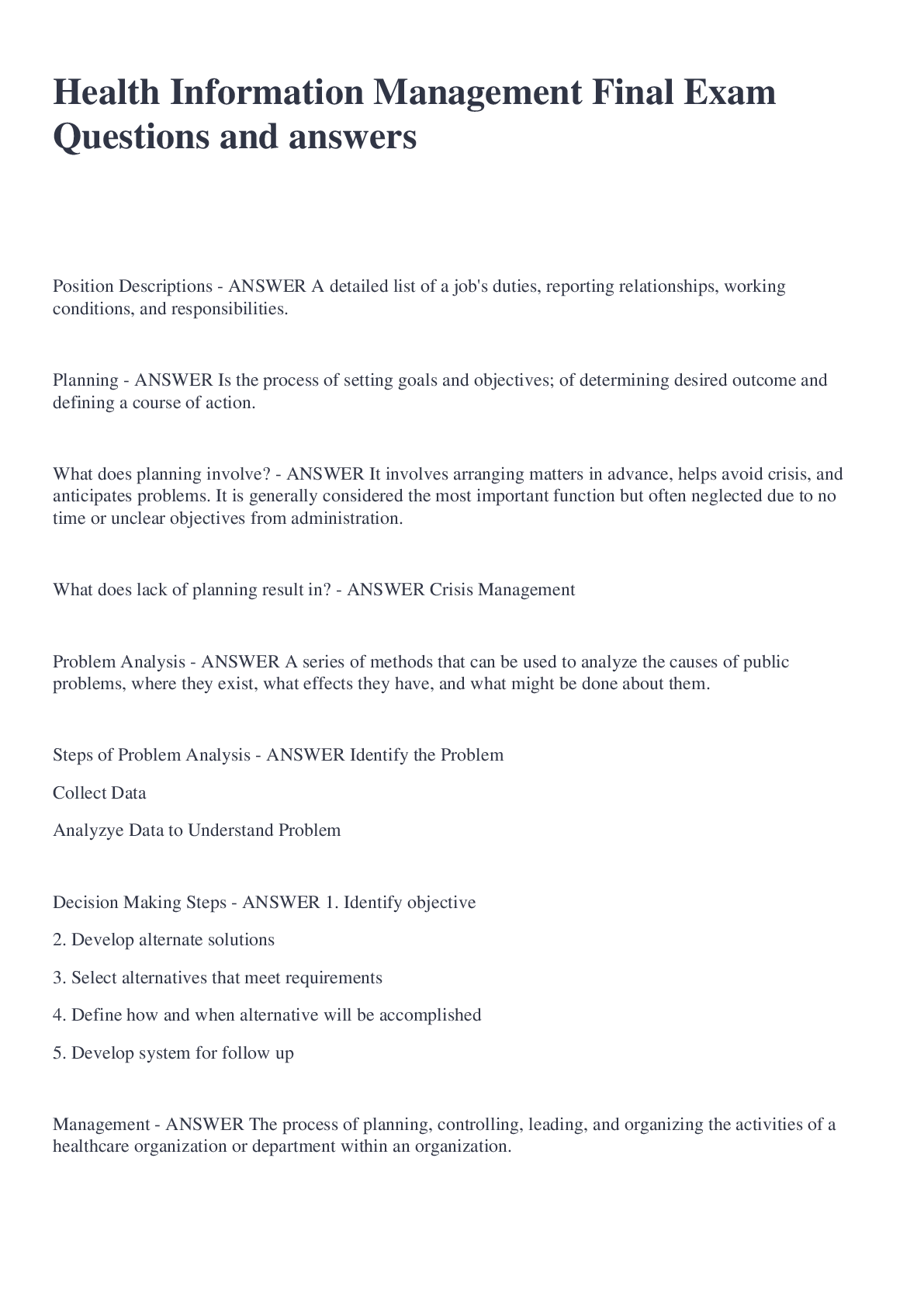
Buy this document to get the full access instantly
Instant Download Access after purchase
Buy NowInstant download
We Accept:

Reviews( 0 )
$10.00
Can't find what you want? Try our AI powered Search
Document information
Connected school, study & course
About the document
Uploaded On
Sep 25, 2022
Number of pages
52
Written in
Additional information
This document has been written for:
Uploaded
Sep 25, 2022
Downloads
0
Views
103


